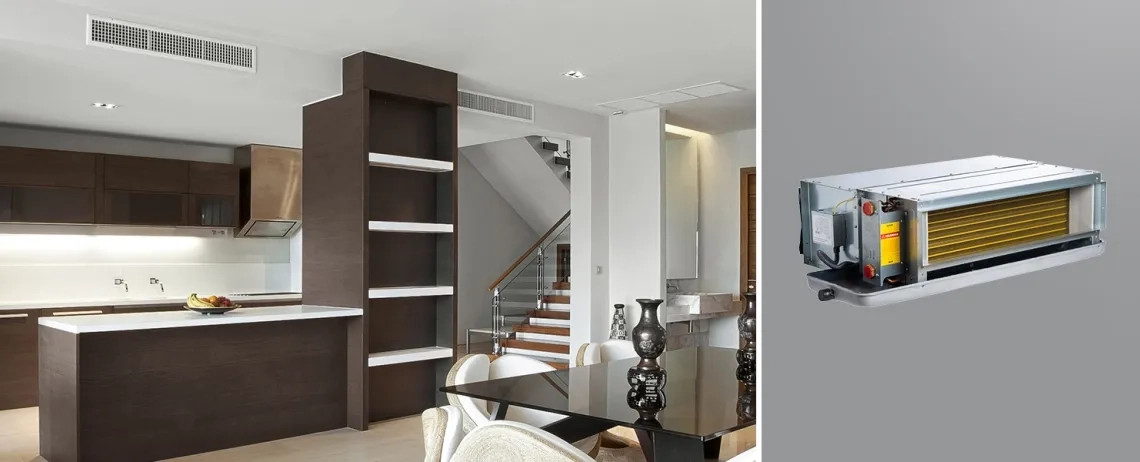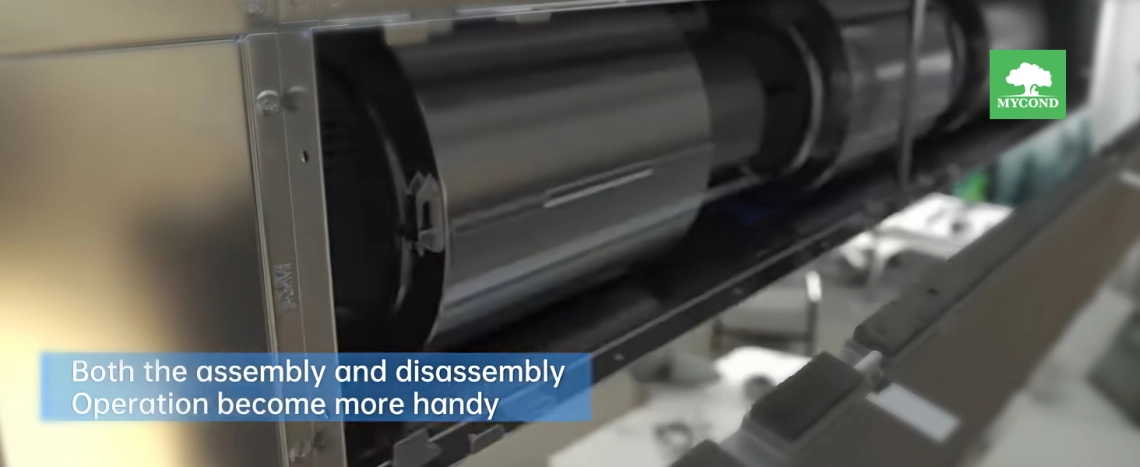
Reading Time: 7 Minutes
Introduction: Modern Solutions for Fan Coil Units
One of the key trends in the HVAC industry is the shift from traditional closed-design fan coil units or angled structures to new designs that simplify installation and maintenance. In this article, we will explore how innovative fan coil unit designs can benefit installers and the advantages offered by modern technologies and concepts.
What is a Fan Coil Unit?
A fan coil unit (FCU) is an HVAC system component that operates on a decentralized principle, with terminal units (fan coil units) located near the user space and supported by central heating and cooling systems. Fan coil units can be used in a variety of building types, including hotels, offices, schools, and residential complexes.
Key Features of Fan Coil Units
- System Components: Fan coil units consist of a casing, fan, motor, heat exchanger (coil) with a drain pan, and a filter.
- Types of Fan Coil Units: There are various configurations of fan coil units, including wall-mounted, ceiling-mounted (exposed and concealed), horizontal, vertical, and high-capacity models.
- Operating Principle: Fan coil units use heated water from a central heat source and chilled water from a central cooling system. A fan, powered by a small electric motor, circulates air through the filter and heat exchanger.
Advantages of Fan Coil Units
Fan coil units offer highly efficient energy usage through a dual water circuit system (hot and cold), minimizing water transport costs and pump operation. This makes fan coil units an ideal solution for buildings seeking energy-efficient heating and cooling methods.
How Can Design Benefit Installers?
Installing fan coil units and air handling units can be challenging, especially without the right equipment. Here, we highlight the benefits of using preassembled kits that simplify installation, commissioning, and maintenance of these devices. With these kits, installers can save time while improving efficiency and workmanship quality.

Benefits of Using Preassembled Kits
Preassembled kits, as opposed to purchasing individual components, provide assurance to both installers and end users. Thanks to their design specifications, fan coil units in these kits can be customized to specific connection types and flow requirements, simplifying the design and installation process.
Benefits:
- Fewer Connections, Lower Risk of Leaks: The preassembled kits reduce the number of connections, minimizing the risk of leaks and water loss. This also lowers potential maintenance costs.
- Reduced Installation Time: With preassembled designs, installers can complete projects more quickly without the time-consuming assembly of individual components.
- Pretesting: Kits are often tested before shipping, ensuring they meet quality and performance standards, and reducing the likelihood of costly repairs.
Energy Efficiency and Quality
Modern fan coil units are distinguished by their high quality, a critical factor for users seeking energy efficiency and reliability.
Advantages of Modern Fan Coil Units
- Preformed Insulation: Prevents condensation and ensures compliance with fire safety regulations.
- Dynamic Balancing: Equipped with a PICV valve, the system is dynamically balanced, delivering optimal energy efficiency and allowing for easy adjustments.
- Ease of Installation: Designed for easy assembly and versatility, with the ability to adapt to various installation types thanks to interchangeable hoses and valve adjustments.
Fan Coil Unit Comparison: Medium-Pressure vs. Low-Pressure Units
To better understand the differences between various types of fan coil units, here is a comparison of medium-pressure and low-pressure units. The table below will help guide your choice based on project specifications.
| Feature | Medium-Pressure Fan Coil Units | Low-Pressure Fan Coil Units |
|---|---|---|
| Operating Pressure Range | 5–12 bar | 2–5 bar |
| Cooling Efficiency | Higher cooling capacity, used in larger systems | Ideal for medium-sized installations |
| Installation Type | Designed for systems requiring higher pressures | Typically used in lower-demand setups |
| Applications | Large commercial buildings, offices, hotels | Small to medium residential buildings, offices, schools |
| Ease of Installation | More complex installation, requiring more components | Easier installation with fewer requirements |
| Cost | Higher price due to greater capacity and pressure | More economical, suitable for smaller systems |
Recommendations:
- Medium-Pressure Fan Coil Units: Recommended for large-scale installations where high cooling capacity and configurations that are more advanced are required.
- Low-Pressure Fan Coil Units: Ideal for less demanding projects, such as small offices, apartments, or schools.
Expert Opinion
“Modern fan coil units represent a significant step toward enhancing energy efficiency in buildings. The introduction of preassembled kits greatly simplifies the installation process, saving time, reducing the risk of errors, and improving the overall quality of HVAC systems,” says Dr. Jan Kowalski, an expert in HVAC and energy efficiency.
Conclusion: What Are the Benefits of Modern Fan Coil Units?
Modern fan coil units are a leap forward in creating more efficient, energy-saving, and easy-to-install HVAC solutions. Thanks to innovative preassembled kits, installation is simplified, and the overall system is more reliable. For installers, this means less time spent on assembly, and for end users, it results in greater energy savings and longer system lifespan. Fan coil units are paving the way for smarter and more sustainable buildings.
For more information on medium-pressure ducted fan coil units MCFC Series, click here, and for low-pressure ducted fan coil units MCFDS Series, click here.
